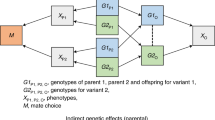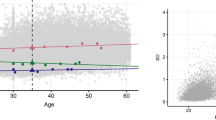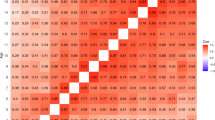Abstract
Objective:
To identify common loci and potential genetic variants affecting body mass index (BMI, kg m−2) in study populations originating from Europe.
Design:
We combined genome-wide linkage scans of six cohorts from Australia, Denmark, Finland, the Netherlands, Sweden and the United Kingdom with an ∼10-cM microsatellite marker map. Variance components linkage analysis was carried out with age, sex and country of origin as covariates.
Subjects:
The GenomEUtwin consortium consists of twin cohorts from eight countries (Australia, Denmark, the Netherlands, Finland, Italy, Norway, Sweden and the United Kingdom) with a total data collection of more than 500 000 monozygotic and dizygotic (DZ) twin pairs. Variance due to early-life events and the environment is reduced within twin pairs, which makes DZ pairs highly valuable for linkage studies of complex traits. This study totaled 4401 European-originated twin families (10 535 individuals) from six countries (Australia, Denmark, the Netherlands, Finland, Sweden and the United Kingdom).
Results:
We found suggestive evidence for a quantitative trait locus on 3q29 and 7q36 in the combined sample of DZ twins (multipoint logarithm of odds score (MLOD) 2.6 and 2.4, respectively). Two individual cohorts showed strong evidence independently for three additional loci: 16q23 (MLOD=3.7) and 2p24 (MLOD=3.4) in the Dutch cohort and 20q13 (MLOD=3.2) in the Finnish cohort.
Conclusion:
Linkage analysis of the combined data in this large twin cohort study provided evidence for suggestive linkage to BMI. In addition, two cohorts independently provided significant evidence of linkage to three new loci. The results of our study suggest a smaller environmental variance between DZ twins than full siblings, with a corresponding increase in heritability for BMI as well as an increase in linkage signal in well-replicated regions. The results are consistent with the possibility of locus heterogeneity for some genomic regions, and indicate a lack of major common quantitative trait locus variants affecting BMI in European populations.
This is a preview of subscription content, access via your institution
Access options
Subscribe to this journal
Receive 12 print issues and online access
$259.00 per year
only $21.58 per issue
Buy this article
- Purchase on Springer Link
- Instant access to full article PDF
Prices may be subject to local taxes which are calculated during checkout


Similar content being viewed by others

References
Landi F, Onder G, Gambassi G, Pedone C, Carbonin P, Bernabei R . Body mass index and mortality among hospitalized patients. Arch Intern Med 2000; 160: 2641–2644.
Frayling TM, Timpson NJ, Weedon MN, Zeggini E, Freathy RM, Lindgren CM et al. A common variant in the FTO gene is associated with body mass index and predisposes to childhood and adult obesity. Science (New York, NY) 2007; 316: 889–894.
Willer CJ, Speliotes EK, Loos RJ, Li S, Lindgren CM, Heid IM et al. Six new loci associated with body mass index highlight a neuronal influence on body weight regulation. Nat Genet 2009; 41: 25–34.
Thorleifsson G, Walters GB, Gudbjartsson DF, Steinthorsdottir V, Sulem P, Helgadottir A et al. Genome-wide association yields new sequence variants at seven loci that associate with measures of obesity. Nat Genet 2009; 41: 18–24.
Loos RJ, Lindgren CM, Li S, Wheeler E, Zhao JH, Prokopenko I et al. Common variants near MC4R are associated with fat mass, weight and risk of obesity. Nat Genet 2008; 40: 768–775.
Meyre D, Delplanque J, Chevre JC, Lecoeur C, Lobbens S, Gallina S et al. Genome-wide association study for early-onset and morbid adult obesity identifies three new risk loci in European populations. Nat Genet 2009; 41: 157–159.
Bell CG, Walley AJ, Froguel P . The genetics of human obesity. Nat Rev 2005; 6: 221–234.
Clement K, Sørensen TIA . Obesity: Genomics and Postgenomics. Informa Healthcare: New York, USA, 2007.
Perola M, Sammalisto S, Hiekkalinna T, Martin NG, Visscher PM, Montgomery GW et al. Combined genome scans for body stature in 6,602 European twins: evidence for common Caucasian loci. PLoS Genet 2007; 3: e97.
Hopper JL . The Australian Twin Registry. Twin Res 2002; 5: 329–336.
Skytthe A, Kyvik K, Holm NV, Vaupel JW, Christensen K . The Danish Twin Registry: 127 birth cohorts of twins. Twin Res 2002; 5: 352–357.
Kaprio J, Koskenvuo M . Genetic and environmental factors in complex diseases: the older Finnish Twin Cohort. Twin Res 2002; 5: 358–365.
Boomsma DI, Vink JM, van Beijsterveldt TC, de Geus EJ, Beem AL, Mulder EJ et al. Netherlands Twin Register: a focus on longitudinal research. Twin Res 2002; 5: 401–406.
Pedersen NL, Lichtenstein P, Svedberg P . The Swedish Twin Registry in the third millennium. Twin Res 2002; 5: 427–432.
Spector TD, MacGregor AJ . The St. Thomas' UK Adult Twin Registry. Twin Res 2002; 5: 440–443.
Sammalisto S, Hiekkalinna T, Suviolahti E, Sood K, Metzidis A, Pajukanta P et al. A male-specific quantitative trait locus on 1p21 controlling human stature. J Med Genet 2005; 42: 932–939.
Abecasis GR, Cherny SS, Cookson WO, Cardon LR . GRR: graphical representation of relationship errors. Bioinformatics (Oxford, England) 2001; 17: 742–743.
O'Connell JR, Weeks DE . PedCheck: a program for identification of genotype incompatibilities in linkage analysis. Am J Hum Genet 1998; 63: 259–266.
Abecasis GR, Cherny SS, Cookson WO, Cardon LR . Merlin—rapid analysis of dense genetic maps using sparse gene flow trees. Nat Genet 2002; 30: 97–101.
Hiekkalinna T, Terwilliger JD, Sammalisto S, Peltonen L, Perola M . AUTOGSCAN: powerful tools for automated genome-wide linkage and linkage disequilibrium analysis. Twin Res Hum Genet 2005; 8: 16–21.
Keith SW, Redden DT, Katzmarzyk PT, Boggiano MM, Hanlon EC, Benca RM et al. Putative contributors to the secular increase in obesity: exploring the roads less traveled. Int J Obes (2005) 2006; 30: 1585–1594.
Maes HH, Neale MC, Eaves LJ . Genetic and environmental factors in relative body weight and human adiposity. Behav Genet 1997; 27: 325–351.
Schousboe K, Willemsen G, Kyvik KO, Mortensen J, Boomsma DI, Cornes BK et al. Sex differences in heritability of BMI: a comparative study of results from twin studies in eight countries. Twin Res 2003; 6: 409–421.
Rankinen T, Zuberi A, Chagnon YC, Weisnagel SJ, Argyropoulos G, Walts B et al. The human obesity gene map: the 2005 update. Obesity (Silver Spring, MD) 2006; 14: 529–644.
Hjelmborg JB, Fagnani C, Silventoinen K, McGue M, Korkeila M, Christensen K et al. Genetic influences on growth traits of BMI: a longitudinal study of adult twins. Obesity (Silver Spring, MD) 2008; 16: 847–852.
Ortega-Alonso A, Sipila S, Kujala UM, Kaprio J, Rantanen T . Genetic influences on change in BMI from middle to old age: a 29-year follow-up study of twin sisters. Behav Genet 2008; 39: 154–164.
Francke S, Manraj M, Lacquemant C, Lecoeur C, Lepretre F, Passa P et al. A genome-wide scan for coronary heart disease suggests in Indo-Mauritians a susceptibility locus on chromosome 16p13 and replicates linkage with the metabolic syndrome on 3q27. Hum Mol Genet 2001; 10: 2751–2765.
Kissebah AH, Sonnenberg GE, Myklebust J, Goldstein M, Broman K, James RG et al. Quantitative trait loci on chromosomes 3 and 17 influence phenotypes of the metabolic syndrome. Proc Natl Acad Sci USA 2000; 97: 14478–14483.
Luke A, Wu X, Zhu X, Kan D, Su Y, Cooper R . Linkage for BMI at 3q27 region confirmed in an African-American population. Diabetes 2003; 52: 1284–1287.
Vionnet N, Hani EH, Dupont S, Gallina S, Francke S, Dotte S et al. Genomewide search for type 2 diabetes-susceptibility genes in French whites: evidence for a novel susceptibility locus for early-onset diabetes on chromosome 3q27-qter and independent replication of a type 2-diabetes locus on chromosome 1q21-q24. Am J Hum Genet 2000; 67: 1470–1480.
Walder K, Hanson RL, Kobes S, Knowler WC, Ravussin E . An autosomal genomic scan for loci linked to plasma leptin concentration in Pima Indians. Int J Obes Relat Metab Disord 2000; 24: 559–565.
Wu X, Cooper RS, Borecki I, Hanis C, Bray M, Lewis CE et al. A combined analysis of genomewide linkage scans for body mass index from the National Heart, Lung, and Blood Institute Family Blood Pressure Program. Am J Hum Genet 2002; 70: 1247–1256.
Sammalisto S, Hiekkalinna T, Schwander K, Kardia S, Weder AB, Rodriguez BL et al. Genome-wide linkage screen for stature and body mass index in 3.032 families: evidence for sex- and population-specific genetic effects. Eur J Hum Genet 2009; 17: 258–266.
Feitosa MF, Borecki IB, Rich SS, Arnett DK, Sholinsky P, Myers RH et al. Quantitative-trait loci influencing body-mass index reside on chromosomes 7 and 13: the National Heart, Lung, and Blood Institute Family Heart Study. Am J Hum Genet 2002; 70: 72–82.
Hsueh WC, Mitchell BD, Schneider JL, St Jean PL, Pollin TI, Ehm MG et al. Genome-wide scan of obesity in the Old Order Amish. J Clin Endocrinol Metab 2001; 86: 1199–1205.
Pérusse L, Rice T, Chagnon YC, Despres JP, Lemieux S, Roy S et al. A genome-wide scan for abdominal fat assessed by computed tomography in the Quebec Family Study. Diabetes 2001; 50: 614–621.
Comuzzie AG, Hixson JE, Almasy L, Mitchell BD, Mahaney MC, Dyer TD et al. A major quantitative trait locus determining serum leptin levels and fat mass is located on human chromosome 2. Nat Genet 1997; 15: 273–276.
Hager J, Dina C, Francke S, Dubois S, Houari M, Vatin V et al. A genome-wide scan for human obesity genes reveals a major susceptibility locus on chromosome 10. Nat Genet 1998; 20: 304–308.
Mitchell BD, Cole SA, Comuzzie AG, Almasy L, Blangero J, MacCluer JW et al. A quantitative trait locus influencing BMI maps to the region of the beta-3 adrenergic receptor. Diabetes 1999; 48: 1863–1867.
Palmer LJ, Buxbaum SG, Larkin E, Patel SR, Elston RC, Tishler PV et al. A whole-genome scan for obstructive sleep apnea and obesity. Am J Hum Genet 2003; 72: 340–350.
Norman RA, Tataranni PA, Pratley R, Thompson DB, Hanson RL, Prochazka M et al. Autosomal genomic scan for loci linked to obesity and energy metabolism in Pima Indians. Am J Hum Genet 1998; 62: 659–668.
Dong C, Wang S, Li WD, Li D, Zhao H, Price RA . Interacting genetic loci on chromosomes 20 and 10 influence extreme human obesity. Am J Hum Genet 2003; 72: 115–124.
Hunt SC, Abkevich V, Hensel CH, Gutin A, Neff CD, Russell DL et al. Linkage of body mass index to chromosome 20 in Utah pedigrees. Hum Genet 2001; 109: 279–285.
Lee JH, Reed DR, Li WD, Xu W, Joo EJ, Kilker RL et al. Genome scan for human obesity and linkage to markers in 20q13. Am J Hum Genet 1999; 64: 196–209.
Wu X, Luke A, Cooper RS, Zhu X, Kan D, Tayo BO et al. A genome scan among Nigerians linking resting energy expenditure to chromosome 16. Obes Res 2004; 12: 577–581.
Wilson SG, Adam G, Langdown M, Reneland R, Braun A, Andrew T et al. Linkage and potential association of obesity-related phenotypes with two genes on chromosome 12q24 in a female dizygous twin cohort. Eur J Hum Genet 2006; 14: 340–348.
Heijmans BT, Beem AL, Willemsen G, Posthuma D, Slagboom PE, Boomsma D . Further evidence for a QTL influencing body mass index on chromosome 7p from a genome-wide scan in Dutch families. Twin Res 2004; 7: 192–196.
Perola M, Ohman M, Hiekkalinna T, Leppavuori J, Pajukanta P, Wessman M et al. Quantitative-trait-locus analysis of body-mass index and of stature, by combined analysis of genome scans of five Finnish study groups. Am J Hum Genet 2001; 69: 117–123.
Cornes BK, Medland SE, Ferreira MA, Morley KI, Duffy DL, Heijmans BT et al. Sex-limited genome-wide linkage scan for body mass index in an unselected sample of 933 Australian twin families. Twin Res Hum Genet 2005; 8: 616–632.
Kring SI, Holst C, Zimmermann E, Jess T, Berentzen T, Toubro S et al. FTO gene associated fatness in relation to body fat distribution and metabolic traits throughout a broad range of fatness. PLoS ONE 2008; 3: e2958.
Bodmer W, Bonilla C . Common and rare variants in multifactorial susceptibility to common diseases. Nat Genet 2008; 40: 695–701.
Farooqi IS, Keogh JM, Yeo GS, Lank EJ, Cheetham T, O'Rahilly S . Clinical spectrum of obesity and mutations in the melanocortin 4 receptor gene. N Engl J Med 2003; 348: 1085–1095.
Vaisse C, Clement K, Durand E, Hercberg S, Guy-Grand B, Froguel P . Melanocortin-4 receptor mutations are a frequent and heterogeneous cause of morbid obesity. J Clin Invest 2000; 106: 253–262.
Acknowledgements
This project is supported by the European Commission under the program ‘Quality of Life and Management of the Living Resources’ of 5th Framework Programme (no. QLG2-CT-2002-01254), Genome-Wide Analyses of European Twin and Population Cohorts (EU/QLRT-2001-01254), NIH/NHLBI: STAMPEED (Genetics of cardiovascular risk factors in large founder population birth cohorts, 1-R01-HL087679-01), by the Finnish Heart Association, the Sigrid Juselius Foundation and the Academy of Finland Centre of Excellence in Complex Disease Genetics. TwinsUK is supported by the Wellcome Trust, the BBSRC and an NHS NIHR Biomedical research centre Grant to KCL and Guys and St Thomas' foundation hospitals trust. The Swedish twin registry was supported by Swedish Research Council (no. M-2005-1112) and the Swedish Foundation for Strategic Research. The Australian Twin Registry was supported in part by Grants from NIAAA (USA): AA007535, AA013320, AA013326, AA014041, AA07728, AA10249, AA11998, and NHMRC (Australia): 941177, 951023, 950998, 981339, 241916 and 941944. The Netherlands Twin Register was supported by the Netherlands Heart Foundation (86.083, 88.042, 90.313), the Netherlands Organisation for Scientific Research (904-61-090; SPI 56-464-14192; 480-04-004), Center Medical Systems Biology (NWO Genomics), Genome Scan for Neuroticism (National Institute of Mental Health Grant no. R01 MH059160). Samples were genotyped by the Mammalian Genotyping Service in Marshfield and the Molecular Epidemiology Section, Leiden University Medical Centre. The Danish Twin Registry has been supported by the Danish Medical Research Council, The Danish Diabetes Foundation, the Danish Heart Foundation and the Novo Nordisk Foundation.
Author information
Authors and Affiliations
Consortia
Corresponding author
Rights and permissions
About this article
Cite this article
Kettunen, J., Perola, M., Martin, N. et al. Multicenter dizygotic twin cohort study confirms two linkage susceptibility loci for body mass index at 3q29 and 7q36 and identifies three further potential novel loci. Int J Obes 33, 1235–1242 (2009). https://doi.org/10.1038/ijo.2009.168
Received:
Revised:
Accepted:
Published:
Issue Date:
DOI: https://doi.org/10.1038/ijo.2009.168
Keywords
This article is cited by
-
Association between LGR4 polymorphisms and peak bone mineral density and body composition
Journal of Bone and Mineral Metabolism (2020)
-
Ablation of LGR4 promotes energy expenditure by driving white-to-brown fat switch
Nature Cell Biology (2013)
-
Causes and consequences of obesity: the contribution of recent twin studies
International Journal of Obesity (2012)
-
High-Resolution Genome-Wide Linkage Mapping Identifies Susceptibility Loci for BMI in the Chinese Population
Obesity (2012)
-
Aberrant glycosylation of IgA1 is inherited in both pediatric IgA nephropathy and Henoch–Schönlein purpura nephritis
Kidney International (2011)


